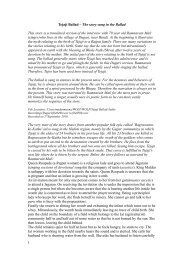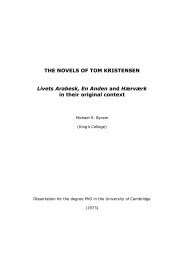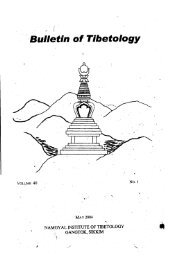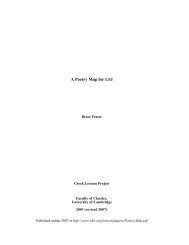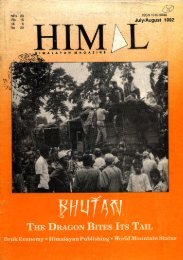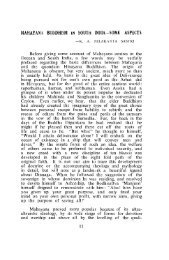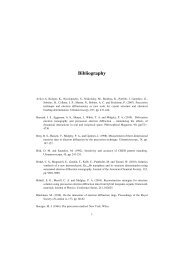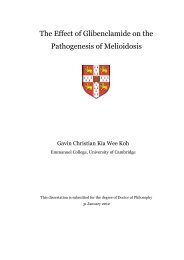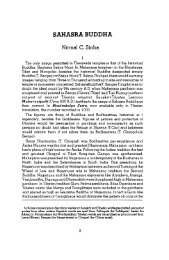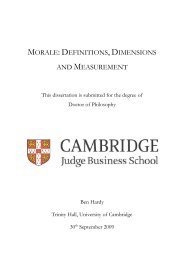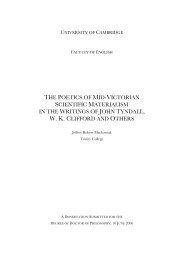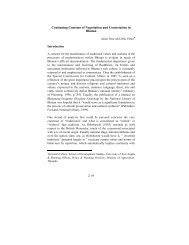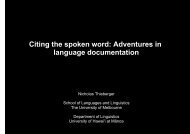The Crusades, the Genoese and the Latin East - DSpace at ...
The Crusades, the Genoese and the Latin East - DSpace at ...
The Crusades, the Genoese and the Latin East - DSpace at ...
Create successful ePaper yourself
Turn your PDF publications into a flip-book with our unique Google optimized e-Paper software.
<strong>the</strong> crusades are reflected on <strong>the</strong> activities of individual <strong>Genoese</strong> whose records were registered<br />
by <strong>the</strong> notaries.<br />
One of <strong>the</strong> main arguments in this dissert<strong>at</strong>ion is th<strong>at</strong> it is possible to learn much about<br />
<strong>the</strong> crusading period from <strong>the</strong> commercial contracts. This argument is especially true regarding<br />
<strong>the</strong> involvement of <strong>the</strong> <strong>Genoese</strong> in <strong>the</strong> Third Crusade because almost every commercial <strong>and</strong><br />
travelling contract th<strong>at</strong> was signed in <strong>the</strong> years 1190 to 1192 (th<strong>at</strong> is <strong>the</strong> only period of <strong>the</strong> Third<br />
Crusade from which cartularies remain) concerns, in one way or ano<strong>the</strong>r, <strong>the</strong> movement of <strong>the</strong><br />
crusade's contingents. This argument also applies to <strong>the</strong> Fourth <strong>and</strong> Fifth <strong>Crusades</strong>. Despite <strong>the</strong><br />
fact th<strong>at</strong> Genoa did not take part in <strong>the</strong> Fourth Crusade, it was still highly affected<br />
by it, for<br />
example, a significant effect of <strong>the</strong> crusade was th<strong>at</strong> some of <strong>the</strong> routes followed by <strong>Genoese</strong><br />
merchants had changed. It will also be argued th<strong>at</strong> gaining knowledge about merchants' activities<br />
in <strong>the</strong> Mediterranean Sea during this period provides insight into peoples' perceptions of <strong>the</strong><br />
Fourth Crusade. Many questions are addressed in <strong>the</strong> various chapters about <strong>the</strong> involvement of<br />
<strong>the</strong> <strong>Genoese</strong> in each crusade, <strong>the</strong>ir motiv<strong>at</strong>ions to cooper<strong>at</strong>e or not to get involved <strong>and</strong> <strong>the</strong>ir<br />
reaction to <strong>the</strong> activities of o<strong>the</strong>r powers. More <strong>at</strong>tention is given to those individuals <strong>and</strong> families<br />
who established strong rel<strong>at</strong>ionships with <strong>the</strong> crusader st<strong>at</strong>es, <strong>and</strong> especially to those who settled<br />
in <strong>the</strong> <strong>L<strong>at</strong>in</strong> <strong>East</strong>. How were such individuals <strong>and</strong> families affected by <strong>the</strong>ir emigr<strong>at</strong>ion from<br />
Genoa? Is <strong>the</strong>re evidence of change in <strong>the</strong>ir economic situ<strong>at</strong>ion, social st<strong>at</strong>us or even<br />
identity? In<br />
wh<strong>at</strong> ways did <strong>the</strong> permanent presence of <strong>Genoese</strong> in <strong>the</strong> <strong>L<strong>at</strong>in</strong> <strong>East</strong> affected Genoa's commercial<br />
web? Many o<strong>the</strong>r questions spring to mind when <strong>the</strong>se issues are carefully analysed. <strong>The</strong>se<br />
questions will be introduced <strong>at</strong> <strong>the</strong> beginning of each chapter.<br />
<strong>The</strong> first three chapters concern <strong>the</strong> crusading experience of <strong>the</strong> <strong>Genoese</strong> over several<br />
decades,<br />
from <strong>the</strong> time of <strong>the</strong> Thirds Crusade until <strong>the</strong> Fifth Crusade. Chapters Four <strong>and</strong> Five are<br />
about <strong>the</strong> <strong>Genoese</strong> in <strong>the</strong> <strong>L<strong>at</strong>in</strong> <strong>East</strong>: in Byblos, which was a crusader town in <strong>the</strong> County of<br />
Tripoli, <strong>and</strong> in <strong>the</strong> kingdom of Jerusalem. Each of <strong>the</strong> three crusades was a special enterprise,<br />
with its own collection of chronicles <strong>and</strong> diplom<strong>at</strong>ic documents. Each has different<br />
methodological concerns, which explains why in modem historiography <strong>the</strong> crusades are usually<br />
studied separ<strong>at</strong>ely. Monographs have been written about <strong>the</strong> Fourth <strong>and</strong> <strong>the</strong> Fifth <strong>Crusades</strong> <strong>and</strong><br />
many works have been dedic<strong>at</strong>ed to different aspects of <strong>the</strong> Third Crusade. This is <strong>the</strong> reason th<strong>at</strong><br />
<strong>the</strong>re are liter<strong>at</strong>ure reviews included as part of <strong>the</strong> introduction <strong>at</strong> <strong>the</strong> beginning of each chapter.<br />
None<strong>the</strong>less, <strong>the</strong>re is a large body of works th<strong>at</strong> has been used throughout this dissert<strong>at</strong>ion.<br />
Studies on commerce in <strong>the</strong> Mediterranean <strong>and</strong> on Genoa are frequently mentioned in <strong>the</strong><br />
different chapters. Such are <strong>the</strong> works on <strong>the</strong> history of <strong>the</strong> <strong>Genoese</strong> in <strong>the</strong> Middle-Ages by Erik<br />
Bach, Geo Pistarino, Roberto Lopez, Eliyahu Ashtor, Eugene Byrne, <strong>and</strong> more recently by David<br />
Abulafia, Gabriella Airaldi, Laura Balletto, Steven Epstein, David Jacoby, Michel Balard,<br />
9



